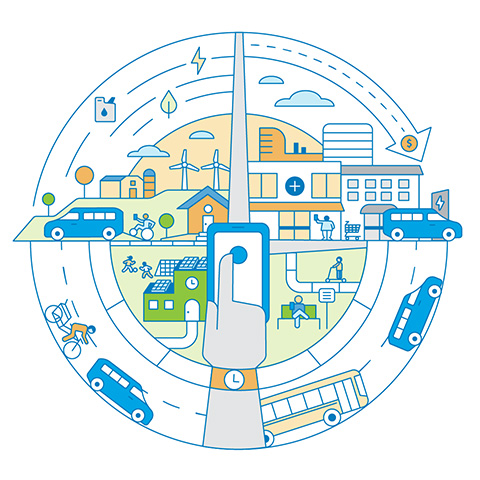On-Demand Transit
NLR works in partnership with communities and transit agencies across the nation and beyond to support and evaluate customized on-demand transit solutions.
Mobility researchers advise communities on technology and system designs in tandem with data gathering and analysis to assess the effectiveness of on-demand transit operations. Key considerations in NLR's analyses include cost, travel time, fuel use, ridership, and customer satisfaction.
Reshaping Mobility

Akin to ride-hailing services such as Uber and Lyft, on-demand transit (also known as on-demand mobility or microtransit) offers flexible, point-to-point, shared transportation.
On-demand transit offers a scalable public transportation option in diverse areas—such as rural and small communities—where traditional public transit services may be lacking or fixed-route services are incompatible with an area's sparse population and demand patterns. Such deficiencies can result in mobility challenges for residents who need access to jobs, healthcare, childcare, and other essential services. NLR analysis results based on real-world projects show that on-demand transit can effectively meet the needs of people in these communities by providing affordable, flexible transportation.
Meanwhile, in suburban and urban areas, on-demand transit can improve regional accessibility by providing first-mile/last-mile connections to traditional transit services as well as short, high-frequency trips to meet day-to-day needs within the community.
Designing Efficient and Affordable Mobility
Shared rides can be hailed via smartphone app, website, or telephone, and payments can be made with cash, credit card, or reloadable smart card. This flexibility makes it easier for people without cell phones or bank accounts to use the service.
According to NLR analysis, on-demand transit typically offers shorter ride and wait times than traditional fixed-route transit—particularly in low-density areas such as suburbs, exurbs, and rural areas. It can also lead to lower operating and ridership costs as well as reduced fuel use in these contexts. This is due in part to the use of vehicles that are "rightsized" to demand—for example, vans or shuttle buses seating up to six passengers versus larger buses—along with reductions in the number of trips taken by single-occupancy vehicles and unfilled buses.
To further reduce costs, NLR is exploring the integration of fully electric and hybrid electric vehicles alongside innovative micromobility solutions such as e-bikes and e-scooters.
Creating an Evaluation Framework for On-Demand Mobility
NLR has identified key criteria to track and measure for evaluating the effectiveness of on-demand transit systems:
- System operations – Dispatch and route planning, hours of operation, and annual budget
- Vehicle fleet – Fleet composition, origin-destination pairs, vehicle miles traveled, and energy impacts
- Ridership – Ridership numbers, passenger wait and travel time, demographics, and passenger satisfaction
- System operational efficiency – Percentage of shared rides, trip cancellation rate, number of passengers per day per vehicle, and trip denial rate.
Communities and transit agencies can employ this evaluation framework along with lessons learned from real-world projects, described below, to inform the design and evaluation of on-demand transit solutions for their regions.
Publications
These publications offer insight and results from on-demand transit projects across the continental United States along with communities in Puerto Rico and Canada.
Mobility Energy Productivity Evaluation of On-Demand Transit: A Case Study in Arlington, Texas, Transportation Research Record (2024)
The Transportation Research Board recognized the authors of this article with the William W. Millar Award for best paper in the area of public transportation.
Community Public Mobility Using On-Demand, Low-Speed Electric Vehicles: A Case Study in Downtown St. Louis, Missouri, Transportation Research Record (2024)
A Mobility Energy Productivity Evaluation of On-Demand Transit: A Case Study in Arlington,
Texas, NLR Presentation (2024)
Fort Erie On-Demand Transit Case Study, NLR Technical Report (2023)
Fort Erie Case Study: Transition from Fixed-Route to On-Demand Transit, NLR Presentation (2023)
Contact
Contact us to learn more about NLR's on-demand transit research or explore related partnership opportunities.
Share
Last Updated Dec. 7, 2025
